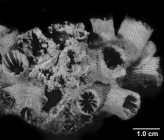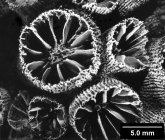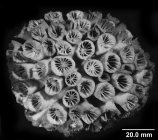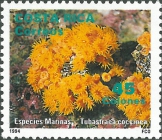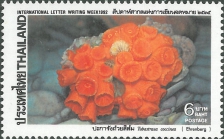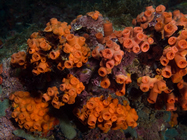
| About | | Search taxa | | Taxon tree | | Search literature | | Checklist | | Stats | | Log in |
WoRMS taxon detailsTubastraea coccinea Lesson, 1830
291251 (urn:lsid:marinespecies.org:taxname:291251)
accepted
Species
Astropsammia pedersenii Verrill, 1869 · unaccepted > junior subjective synonym
Caryophyllia aurantiaca (Dana, 1846) · unaccepted > junior subjective synonym
Caryophyllia calycularis Lamarck, 1836 · unaccepted > junior subjective synonym
Cladocora calycularis (Lamarck, 1836) · unaccepted > junior subjective synonym
Coenopsammia affinis (Duncan, 1889) · unaccepted > junior subjective synonym
Coenopsammia coccinea (Lesson, 1830) · unaccepted > superseded combination (basionym)
Coenopsammia ehrenbergiana Milne Edwards & Haime, 1848 · unaccepted > junior subjective synonym
Coenopsammia gaimardi Milne Edwards & Haime, 1848 · unaccepted > junior subjective synonym
Coenopsammia manni Verrill, 1866 · unaccepted > junior subjective synonym
Coenopsammia radiata Verrill, 1864 · unaccepted > junior subjective synonym
Coenopsammia tenuilamellosa Milne Edwards & Haime, 1848 · unaccepted > junior subjective synonym
Coenopsammia urvillii Milne Edwards & Haime, 1848 · unaccepted > junior subjective synonym
Dendrophyllia (Coenopsammia) affinis Duncan, 1889 · unaccepted > junior subjective synonym
Dendrophyllia affinis Duncan, 1889 · unaccepted > junior subjective synonym
Dendrophyllia aurantiaca Dana, 1846 · unaccepted > junior subjective synonym
Dendrophyllia circularis Verrill, 1869 · unaccepted > junior subjective synonym (amended spelling)
Dendrophyllia coccinea (Lesson, 1830) · unaccepted > superseded combination
Dendrophyllia ehrenbergiana (Milne Edwards & Haime, 1848) · unaccepted > junior subjective synonym
Dendrophyllia manni (Verrill, 1866) · unaccepted > junior subjective synonym
Dendrophyllia radiata (Verrill, 1864) · unaccepted > junior subjective synonym
Dendrophyllia surcularis Verrill, 1869 · unaccepted > junior subjective synonym (incorrect original spelling)
Dendrophyllia tenuilamellosa (Milne Edwards & Haime, 1848) · unaccepted > junior subjective synonym
Dendrophyllia turbinata Nemenzo, 1960 · unaccepted > junior subjective synonym
Lobopsammia darwini Duncan, 1876 · unaccepted > junior subjective synonym
Pachypsammia valida Verrill, 1866 · unaccepted > junior subjective synonym (misspelling)
Pachysammia valida Verrill, 1866 · unaccepted > junior subjective synonym
Placopsammia darwini Duncan, 1876 · unaccepted > junior subjective synonym
Tubastaea coccinea Lesson, 1830 · unaccepted > misspelling - incorrect subsequent spelling
Tubastraea pedersenii (Verrill, 1869) · unaccepted > junior subjective synonym
Tubastraea tenuilamellosa (Milne Edwards & Haime, 1848) · unaccepted > junior subjective synonym
Tubastrea circularis (Verrill, 1869) · unaccepted > junior subjective synonym (amended spelling)
Tubastrea coccinea Lesson, 1830 · unaccepted > misspelling - incorrect subsequent spelling
Tubastrea coccinia Lesson, 1930 · unaccepted > misspelling - incorrect subsequent spelling
Tubastrea turbinata (Nemenzo, 1960) · unaccepted > junior subjective synonym
Tubastreae coccinea Lesson, 1830 · unaccepted > misspelling - incorrect subsequent spelling
marine,
Lesson, R.P. (1830). Voyage autour du monde : exécuté par ordre du roi, sur la corvette de Sa Majesté, la Coquille, pendant les années 1822, 1823, 1824, et 1825, par M. L.I. Duperrey. <em>Zoologie 2,.</em> Paris, 1826-1830. (vol. 2, pt 2, 2e division, 1830)., available online at https://www.biodiversitylibrary.org/page/38663489 [details]
Holotype MNHN, verbatimGeounit Bora Bora, Society I...
Holotype MNHN, verbatimGeounit Bora Bora, Society I... [details]
Type locality Bora Bora, Society Islands [details]
Depth range 0-110 m
Depth range 0-110 m [details]
Hoeksema, B. W.; Cairns, S. (2025). World List of Scleractinia. Tubastraea coccinea Lesson, 1830. Accessed through: World Register of Marine Species at: https://www.marinespecies.org/aphia.php?p=taxdetails&id=291251 on 2025-07-16
Date action by
Nomenclatureoriginal description
Lesson, R.P. (1830). Voyage autour du monde : exécuté par ordre du roi, sur la corvette de Sa Majesté, la Coquille, pendant les années 1822, 1823, 1824, et 1825, par M. L.I. Duperrey. <em>Zoologie 2,.</em> Paris, 1826-1830. (vol. 2, pt 2, 2e division, 1830)., available online at https://www.biodiversitylibrary.org/page/38663489 [details] original description (of Dendrophyllia aurantiaca Dana, 1846) Dana, J.D. (1846-1849). Zoophytes. United States Exploring Expedition during the years 1838-1842. <em>Lea and Blanchard, Philadelphia.</em> 7: 1-740, 61 pls. (1846: 1-120, 709-720; 1848: 121-708, 721-740; 1849: atlas pls. 1-61)., available online at https://www.biodiversitylibrary.org/page/18989497, http://www.sil.si.edu/digitalcollections/usexex/navigation/ScientificText/USExEx19_08select.cfm [details] original description (of Dendrophyllia surcularis Verrill, 1869) Verrill, A. E. (1869). On New and imperfectly known Echinoderms and Corals. <em>Proceedings of the Boston Society of Natural HIstory.</em> 12: 381-391., available online at http://www.biodiversitylibrary.org/page/9494023#page/389/mode/1up [details] original description (of Dendrophyllia turbinata Nemenzo, 1960) Nemenzo F (1960) Systematic studies on Philippine shallow water scleractinians: IV. Suborder Dendrophylliida. Natural and Applied Science Bulletin, University of the Philippines 18: 1-22. [details] original description (of Coenopsammia ehrenbergiana Milne Edwards & Haime, 1848) Milne Edwards, H.; Haime, J. (1848). Recherches sur les polypiers. Mémoire 3. Monographie des eupsammides. <em>Annales des Sciences Naturelles, Zoologie, Series 3.</em> 10: 65-114, pls. 5-9. [details] original description (of Coenopsammia gaimardi Milne Edwards & Haime, 1848) Milne Edwards, H.; Haime, J. (1848). Recherches sur les polypiers. Mémoire 3. Monographie des eupsammides. <em>Annales des Sciences Naturelles, Zoologie, Series 3.</em> 10: 65-114, pls. 5-9. [details] original description (of Coenopsammia tenuilamellosa Milne Edwards & Haime, 1848) Milne Edwards, H.; Haime, J. (1848). Recherches sur les polypiers. Mémoire 3. Monographie des eupsammides. <em>Annales des Sciences Naturelles, Zoologie, Series 3.</em> 10: 65-114, pls. 5-9. [details] original description (of Coenopsammia urvillii Milne Edwards & Haime, 1848) Milne Edwards, H.; Haime, J. (1848). Recherches sur les polypiers. Mémoire 3. Monographie des eupsammides. <em>Annales des Sciences Naturelles, Zoologie, Series 3.</em> 10: 65-114, pls. 5-9. [details] original description (of Coenopsammia radiata Verrill, 1864) Verrill, A. E. (1864). List of the polyps and corals sent by the Museum of Comparative Zoology to other institutions in exchange, with annotations. <em>Bulletin of the Museum of Comparative Zoology.</em> 1: 29-60., available online at https://www.biodiversitylibrary.org/page/6587563 [details] original description (of Coenopsammia manni Verrill, 1866) Verrill AE. (1866). Synopsis of the polyps and corals of the North Pacific Exploring Expedition, under Commodore C. Ringgold and Capt. John Rodgers, U.S.N., from 1853 to 1856. Collected by Dr. Wm. Stimpson, Naturalist to the Expedition. With descriptions of some additional species from the west coast of North America. Part III. Madreporaria. <em>Communications of the Essex Institute, Salem.</em> 5(3): 17-50, pls. 1-2., available online at https://www.biodiversitylibrary.org/page/33204514 [details] original description (of Astropsammia pedersenii Verrill, 1869) Verrill, A. E. (1869). On New and imperfectly known Echinoderms and Corals. <em>Proceedings of the Boston Society of Natural HIstory.</em> 12: 381-391., available online at http://www.biodiversitylibrary.org/page/9494023#page/389/mode/1up [details] original description (of Placopsammia darwini Duncan, 1876) Duncan PM. (1876). Notices of some Deep-sea and Littoral Corals from the Atlantic Ocean, Caribbean, Indian, New-Zealand, Persian Gulf, and Japanese &c. Seas. <em>Proceedings of the Zoological Society of London.</em> 44: 428-442, pls. 38-41., available online at https://www.biodiversitylibrary.org/page/29099627#page/524/mode/1up [details] original description (of Caryophyllia calycularis Lamarck, 1836) Deshayes, G. P.; Milne Edwards, H. (1836). <i>Histoire Naturelle des Animaux sans Vertèbres, présentant les caractères généraux et particuliers de ces animaux, leur distribution, leurs classes, leurs familles, leurs genres, et la citation des principales espèces qui s'y rapportent, par J. B. P. A. de Lamarck</i>. Deuxième édition, Tome deuxième. Histoire des Polypes. J. B. Baillière: Paris. 683 pp. + errata (1 p. unpaginated). <em>In: J. B. P. A. Lamarck. Histoire Naturelle des Animaux sans Vertebres. Paris.</em> , available online at http://www.biodiversitylibrary.org/item/64022 [details] original description (of Dendrophyllia (Coenopsammia) affinis Duncan, 1889) Duncan PM. (1889). On the Madreporaria of the Mergui Archipelago collected for the Trustees of the Indian Museum, Calcutta by Dr. John Anderson, F.R.S., Superintendent of the Museum. <em>Journal of the Linnaean Society, London.</em> 21: 1-25., available online at http://dx.doi.org/10.1111/j.1096-3642.1886.tb00967.x [details] original description (of Pachysammia valida Verrill, 1866) Verrill AE. (1866). Synopsis of the polyps and corals of the North Pacific Exploring Expedition, under Commodore C. Ringgold and Capt. John Rodgers, U.S.N., from 1853 to 1856. Collected by Dr. Wm. Stimpson, Naturalist to the Expedition. With descriptions of some additional species from the west coast of North America. Part III. Madreporaria. <em>Communications of the Essex Institute, Salem.</em> 5(3): 17-50, pls. 1-2., available online at https://www.biodiversitylibrary.org/page/33204514 [details] basis of record Cairns, S.D., B.W. Hoeksema & J. van der Land. (2007). as a contribution to UNESCO-IOC Register of Marine Organisms. (look up in IMIS) [details] Taxonomyredescription
Cairns, S. D. (1991). A Revision of the Ahermatypic Scleractinia of the Galapagos and Cocos Islands. Smithsonian Contributions to Zoology, 504; 44 pp. [details] Available for editors redescription Cairns, S.D. (2000). A revision of the shallow-water azooxanthellate Scleractinia of the western Atlantic. <em>Studies on the Natural History of the Caribbean Region.</em> 75: 1-231. [details] Available for editors redescription Cairns, S.D. (1994). Scleractinia of the temperate North Pacific. <em>Smithsonian Contributions to Zoology.</em> 557: 1-150. [details] Available for editors redescription Cairns, S.D. & H. Zibrowius. (1997). Cnidaria Anthozoa: Azooxanthellate Scleractinia from the Philippine and Indonesian regions. <em>in: Crosnier, A. et al. (Ed.) Résultats des Campagnes MUSORSTOM 16. Campagne Franco-Indonésienne KARUBAR. Mémoires du Muséum national d'Histoire naturelle. Série A, Zoologie.</em> 172: 27-244. (look up in IMIS) [details] Available for editors Othercontext source (Introduced species)
Fofonoff, P.W.; Ruiz, G.M.; Steves, B.; Carlton, J.T. (2014-2024). National Exotic Marine and Estuarine Species Information System (NEMESIS). , available online at http://invasions.si.edu/nemesis [details]
context source (HKRMS) Clark, T. H. (1997). The distribution of ahermatypic corals at cape d' Aguilar, Hong Kong. <em>In: Morton B, editor. Proceedings of the Eighth International Marine Biological Workshop: The Marine Flora and Fauna of Hong Kong and Southern China. Hong Kong University Press, Hong Kong.</em> 4: 219-233. [details] context source (Hexacorallia) Fautin, Daphne G. (2013). Hexacorallians of the World. (look up in IMIS) [details] additional source Cairns, S.D., W.C. Jaap & J.C. Lang. (2009). Scleractinia (Cnidaria) of the Gulf of Mexico. <em>In: Felder DL. Camp DK (eds.) Gulf of Mexico–Origins, Waters, and Biota. Biodiversity. Texas A&M Press, College Station, Texas.</em> Pp. 333–347. [details] Available for editors additional source Cairns, S.D. (2009-2017). On line appendix: Phylogenetic list of the 711 valid Recent azooxanthellate scleractinian species with their junior synonyms and depth ranges, 28 pp. <em>In: Cold-Water Corals: The Biology and Geology of Deep-Sea Coral Habitats.</em> Cambridge University Press, Cambridge. [details] additional source Cairns, S.D. (1998). Azooxanthellate Scleractinia (Cnidaria: Anthozoa) of Western Australia. <em>Records of the Western Australian Museum.</em> 18(4): 361-417. [details] Available for editors additional source Cairns, S.D. (2004). The azooxanthellate Scleractinia (Coelenterata: Anthozoa) of Australia. <em>Records of the Australian Museum.</em> 56(3): 259-329. [details] Available for editors additional source Sammarco, P., S. Porter & S.D. Cairns. (2010). A new coral species introduced into the Atlantic Ocean - Tubastraea micranthus (Ehrenberg 1834) (Cnidaria, Anthozoa, Scleractinia): An invasive threat?. <em>Aquatic Invasions.</em> 5(2): 131-140., available online at https://doi.org/10.3391/ai.2010.5.2.02 [details] additional source Serra, S., Bastos, N., Coutinho, R., Schizas, N.V., Johnsson, R., Neves, E. (2024). Four new species of Tubastraea (Scleractinia, Dendrophylliidae) from the Brazilian Coast, Southwestern Atlantic. <em>Pan-American Journal of Aquatic Sciences.</em> 19(2): 113-135., available online at http://panamjas.org/pdf_artigos/PANAMJAS_19(2)_113-135.pdf [details] Available for editors additional source Cairns, S.D., B.W. Hoeksema & J. van der Land. (1999). Appendix: List of extant stony corals. <em>Atoll Research Bulletin.</em> 459: 13-46. page(s): 27 [details] additional source Veron JEN. (1986). Corals of Australia and the Indo-Pacific. <em>Angus & Robertson Publishers.</em> page(s): 580, 584 [details] additional source Cairns, S.D. & N.B. Keller. (1993). New taxa and distributional records of azooxanthellate Scleractinia from the tropical south-west Indian Ocean, with comments on their zoogeography and ecology. <em>Annals of the South African Museum.</em> 103(5): 213-292, 13 pls. [details] Available for editors additional source Scheer G, Pillai CSG. (1974). Report on Scleractinia from the Nicobar Islands. <em>Zoologica, Stuttgart.</em> 42(122): 1-75. page(s): 10, 64-65, 75, plate 30 [details] additional source Cairns, S.D., L. Gershwin, F.J. Brook, P. Pugh, E.W. Dawson, O.V. Ocaña, W. Vervoort, G. Williams, J.E. Watson, D.M. Opresko, P. Schuchert, P.M. Hine, D.P. Gordon, H.I. Campbell, A.J. Wright, J.A.Sánchez & D.G. Fautin. (2009). Phylum Cnidaria: corals, medusae, hydroids, myxozoans. <em>in: Gordon, D.P. (Ed.) (2009). New Zealand inventory of biodiversity: 1. Kingdom Animalia: Radiata, Lophotrochozoa, Deuterostomia.</em> :59-101., available online at https://repository.si.edu/handle/10088/8431 [details] Available for editors additional source Creed, J. C. (2006). Two invasive alien azooxanthellate corals, Tubastraea coccinea and Tubastraea tagusensis, dominate the native zooxanthellate Mussismilia hispida in Brazil. <em>Coral Reefs.</em> 25(3): 350-350., available online at https://doi.org/10.1007/s00338-006-0105-x page(s): 350, Fig. 1b and c [details] additional source Fenner, D. (2001). Biogeography of three Caribbean corals (Scleractinia) and the invasion of Tubastraea coccinea into the Gulf of Mexico. <em>Bulletin of Marine Science.</em> 69: 1175-1189., available online at http://www.ingentaconnect.com/content/umrsmas/bullmar/2001/00000069/00000003/art00010?crawler=true page(s): 1175-1183 [details] Available for editors additional source Figueira de Paula, A.; Creed, J. C. (2004). Two species of the coral Tubastraea (Cnidaria, Scleractinia) in Brazil: a case of accidental introduction. <em>Bulletin of Marine Science.</em> 74: 175-183. page(s): 175-183 [details] additional source Kitahara, M.V., S.D. Cairns & D.J. Miller. (2010). Monophyletic origin of Caryophyllia (Scleractinia, Caryophylliidae), with descriptions of six new species. <em>Systematics and Biodiversity.</em> 8(1): 91-118., available online at https://doi.org/10.1080/14772000903571088 page(s): 115 [details] Available for editors additional source Lira, S.M.A., Farrapeira, C.M.R., Amaral, F.M.D. & Ramos, C.A.C. (2010). Sessile and sedentary macrofauna from the Pirapama shipwreck, Pernambuco, Brazil. <em>Biota Neotropica, 10(4), 155–166.</em> , available online at https://doi.org/10.1590/S1676-06032010000400021 page(s): 8 [details] additional source Reyes-Bonilla, H. (2002). Checklist of valid names and synonyms of stony corals (Anthozoa: Scleractinia) from the eastern Pacific. <em>Journal of Natural History.</em> 36(1): 1-13., available online at https://doi.org/10.1080/713833841 [details] additional source Arrigoni R, Kitano YF, Stolarski J, Hoeksema BW, Fukami H, Stefani F, Galli P, Montano S, Castoldi E, Benzoni F. (2014). A phylogeny reconstruction of the Dendrophylliidae (Cnidaria, Scleractinia) based on molecular and micromorphological criteria, and its ecological implications. <em>Zoologica Scripta.</em> 43 (6): 661-688., available online at https://doi.org/10.1111/zsc.12072 [details] additional source Reyes J, Santodomingo N, Flórez P. (2010). Corales Escleractinios de Colombia. <em>Instituto de Investigaciones Marinas y Costeras (INVEMAR), Santa Marta, Colombia.</em> pp 1-246. [details] additional source Tachikawa, H. (2005). Azooxanthellate Scleractinia (Hexacorallia, Anthozoa, Cnidaria) collected from Otsuki, Kochi prefecture, Japan. <em>Kuroshio Biosphere.</em> 2: 1-27. [details] additional source Song J-I. (1982). A study on the classification of the Korean Anthozoa 7. Scleractinia (Hexacorallia). <em>Korean Journal of Zoology.</em> 25 (3): 131-148. [details] additional source Kitahara MV. (2007). Species richness and distribution of azooxanthellate Scleractinia in Brazil. <em>Bulletin of Marine Science.</em> 81 (3): 497-518. [details] additional source Fenner, D. P. (2005). Corals of Hawai'i. A Field Guide to the Hard, Black, and Soft Corals of Hawai'i and the Northwest Hawaiian Islands, Including Midway. <em>Mutual Publishing, Ltd., Honolulu.</em> 144 pp. page(s): 26, 82 [details] additional source Song J-I. (1988). A systematic study on the Korean Anthozoa 11.Cnidae of Scleractinia. <em>Korean Journal of Systematic Zoology.</em> Special Issue 2: 26-36. [details] additional source Song J-I. (1991). A systematic study on the Korean Anthozoa 12. Order Scleractinia. <em>Korean Journal of Systematic Zoology.</em> 7 (1): 127-150, pls. 1-3. [details] additional source Choi E, Song J-I. (2017). Three records of the genus Tubastraea (Anthozoa:Hexacorallia: Scleractinia: Dendrophylliidae) from Korea. <em>Animal Systematics, Evolution and Diversity.</em> 33(2): 65-72. [details] additional source Pires DE. (2007). The azooxanthellate coral fauna of Brazil. <em>Bulletin of Marine Science.</em> 81:265-272. [details] additional source Santodomingo, N.; Reyes, J.; Flórez, P.; Chacón-Gómez, I.C.; van Ofwegen, L.P.; Hoeksema, B.W. (2012). Diversity and distribution of azooxanthellate corals in the Colombian Caribbean. <em>Marine Biodiversity.</em> 43(1): 7-22., available online at https://doi.org/10.1007/s12526-012-0131-6 [details] additional source Kitahara, M.V. & S.D. Cairns. (2021). Azooxanthellate Scleractinia (Cnidaria, Anthozoa) from New Caledonia. <em>Mémoires du Muséum national d'Histoire naturelle.</em> 215:1-722. [details] Available for editors additional source Maragos, J. E.; Siciliano, D.; Gulko, D.; VanRavenswaay, D.; Potts, D. C.; Aeby, G. (2004). Nihoa Island coral data compiled from Townsend Cromwell 2000, and Rapture 2000 and 2002 sites [Table 1]. Unpublished. [details] additional source Zlatarski, V. N.; Estalella, N. M. (1980). Scleractinia of Cuba with data on the constituent organisms [in Bulgarian]. Bulgarian Academy of Science. Sophia., pp. 312. page(s): 18, 23, 24, 185, 187-190, 224-227, 244, 247-249, 250, 299, 311 [details] additional source Maragos, J. E.; Molina, M.; Kenyon, J. (2004). Palmyra Atoll coral data compiled from Townsend Cromwell 2000-2002, U.S. Fish and Wildlife Service 2000-2001, and Sette 2004 surveys [Table 8]. UNPUBLISHED, UNPUBLISHED [details] additional source Maragos, J. E.; Gulko, D.; Aeby, G.; Potts, D. C. (2004). Gardner Pinnacles 2000-3 coral data compiled from Rapture 2000 and 2002, and Sette 2003 sites [Table 2]. UNPUBLISHED, Unpublished page(s): 1 [details] additional source Maragos, J. E.; Schmerfeld, J. (2004). Coral survey from Howland Island National Wildlife Refuge, 1998-2004 [Table 3]. UNPUBLISHED, Unpublished page(s): 1 [details] additional source Maragos, J. E.; VanRavenswaay, D.; Gulko, D. (2004). French Frigate Shoals coral data compiled from Townsend Cromwell 2000-2, US Fish and Wildlife Service, Rapture 2000 and 2002, and 2003 Sette surveys [Table 1]. UNPUBLISHED, Unpublished page(s): 1 [details] additional source Maragos, J. E.; Siciliano, D.; VanRavenswaay, D.; Aeby, G.; Kenyon, J.; Gulko, D.; Potts, D. C. (2004). Maro reef coral data compiled from Townsend Cromwell 2000 and 2002, American Islander 2001, Rapture 2000 and 2002, and Sette 2003 surveys [Table 9]. UNPUBLISHED, Unpublished page(s): 1 [details] additional source Maragos, J. E.; Siciliano, D.; VanRavenswaay, D.; Gulko, D.; Aeby, G.; Kenyon, J.; Kenyon, J.; Potts, D. C. (2004). Pearl & Hermes Atoll coral data compiled from Rapture & Townsend Cromwell 2000 and 2002, American Islander 2001, and Sette 2003 surveys [Table 13]. UNPUBLISHED, Unpublished page(s): 1 [details] additional source Maragos, J. E.; Kenyon, J.; Dana, T.; Aeby, G.; Siciliano, D.; VanRavenswaay, D.; Gulko, D.; Potts, D. C. (2004). Midway Atoll coral data compiled from Rapture 2000 and 2002, Townsend Cromwell 2002, US Fish and Wildlife Service 2000, and Sette 2003 surveys [Table 14]. UNPUBLISHED, Unpublished [details] additional source Maragos, J. E.; Potts, D. C.; Aeby, G.; Gulko, D.; Kenyon, J.; Siciliano, D.; VanRavenswaay, D. (2004). 2000-2002 rapid ecological assessment of coral (Anthozoa) on shallow reefs of the Northwestern Hawaiian Islands. Part 1: Species and distribution. Pacific Science, 58(2): 211-230 page(s): 217 [details] additional source Maragos, J. E.; VanRavenswaay, D.; Aeby, G.; Gulko, D.; Kenyon, J.; Siciliano, D.; Potts, D. C. (2004). Kure Atoll coral data compiled from Rapture and Townsend Cromwell 2000 and 2002, and Sette 2003 surveys [Table 15]. UNPUBLISHED, Unpublished page(s): 1 [details] additional source Maragos, J. E. (2004). Baker Island coral data [Table unnumbered]. UNPUBLISHED, Unpublished page(s): 2 [details] additional source Song, J. I. (2000). Cnidaria 2: Anthozoa. Korea Institute of Bioscience and Biotechnology., volume 5, pp. 332. page(s): 286-288 [details] additional source DeFelice, R.; Minton, D.; Godwin, L. S. (2002). Records of Shallow-Water Marine Invertebrates from French Frigate Shoals, Northwestern Hawaiian Islands, with a Note on Noningenous Species: Report to U.S. Fish & Wildlife Service. Bishop Museum. Honolulu, Hawaii., pp. 78. page(s): 26, 51 [details] additional source Maragos, J. E. (1977). Order Scleractinia, Stony Corals. Dennis M. Devaney and Lucius G. Eldredge (eds.). Bishop Museum Press. Honolulu, Hawaii, pp. 84 page(s): 162, 197, 199-200 [details]  Present Present  Present in aphia/obis/gbif/idigbio Present in aphia/obis/gbif/idigbio  Inaccurate Inaccurate  Introduced: alien Introduced: alien  Containing type locality Containing type locality
Holotype MNHN, verbatimGeounit Bora Bora, Society I... [details]
Nontype (of Dendrophyllia manni (Verrill, 1866)) VMM, geounit United States Exclusive Economic Zone [details]
Nontype (of Dendrophyllia turbinata Nemenzo, 1960) MSI C-670, geounit Philippine Exclusive Economic Zone [details]
Nontype (of Tubastraea tenuilamellosa (Milne Edwards & Haime, 1848)) AHF 69.1, geounit Ecuadorean Exclusive Economic Zone [details]
Nontype (of Tubastraea tenuilamellosa (Milne Edwards & Haime, 1848)) AHF 69.10, geounit Ecuadorean Exclusive Economic Zone [details]
Nontype (of Tubastraea tenuilamellosa (Milne Edwards & Haime, 1848)) AHF 69.2, geounit Ecuadorean Exclusive Economic Zone [details]
Nontype (of Tubastraea tenuilamellosa (Milne Edwards & Haime, 1848)) AHF 69.3, geounit Ecuadorean Exclusive Economic Zone [details]
Nontype (of Tubastraea tenuilamellosa (Milne Edwards & Haime, 1848)) AHF 69.4, geounit Ecuadorean Exclusive Economic Zone [details]
Nontype (of Tubastraea tenuilamellosa (Milne Edwards & Haime, 1848)) AHF 69.5, geounit Ecuadorean Exclusive Economic Zone [details]
Nontype (of Tubastraea tenuilamellosa (Milne Edwards & Haime, 1848)) AHF 69.6, geounit Ecuadorean Exclusive Economic Zone [details]
Nontype (of Tubastraea tenuilamellosa (Milne Edwards & Haime, 1848)) AHF 69.7, geounit Ecuadorean Exclusive Economic Zone [details]
Nontype (of Tubastraea tenuilamellosa (Milne Edwards & Haime, 1848)) AHF 69.8 [details]
Nontype (of Tubastraea tenuilamellosa (Milne Edwards & Haime, 1848)) AHF 69.9, geounit Ecuadorean Exclusive Economic Zone [details]
Nontype CAS 66640, geounit Cape Verdean Exclusive Economic Zone [details]
Nontype CAS 66644, geounit Ecuadorean Exclusive Economic Zone [details]
Nontype CAS 66648, geounit Ecuadorean Exclusive Economic Zone [details]
Nontype HLD X2: 127-63, geounit Indian Exclusive Economic Zone [details]
Nontype HLD X2: 127-64 (1,2), geounit Indian Exclusive Economic Zone [details]
Nontype HLD X2: 127-69, geounit Indian Exclusive Economic Zone [details]
Nontype HLD X2: 153-4, geounit Indian Exclusive Economic Zone [details]
Nontype IRCZM [details]
Nontype IRCZM [details]
Nontype NMV F78384, geounit Australian Exclusive Economic Zone [details]
Nontype NMV F78386, geounit Australian Exclusive Economic Zone [details]
Nontype NTM C7250, geounit Australian Exclusive Economic Zone [details]
Nontype SAMA H876, geounit Australian Exclusive Economic Zone [details]
Nontype UAZM Coel. 586, geounit Indonesian Exclusive Economic Zone [details]
Nontype USNM 77258, geounit Ecuadorean Exclusive Economic Zone [details]
Nontype USNM 77263, geounit Ecuadorean Exclusive Economic Zone [details]
Nontype USNM 77264-5, geounit Ecuadorean Exclusive Economic Zone [details]
Nontype USNM 77266, geounit Ecuadorean Exclusive Economic Zone [details]
Nontype USNM 79139, geounit Seychellois Exclusive Economic Zone [details]
Nontype USNM 79141, geounit Seychellois Exclusive Economic Zone [details]
Nontype USNM 83640, geounit Australian Exclusive Economic Zone [details]
Nontype USNM 83645, geounit Philippine Exclusive Economic Zone [details]
Nontype USNM 83649, geounit Australian Exclusive Economic Zone [details]
Nontype USNM 83652, geounit Australian Exclusive Economic Zone [details]
Nontype USNM 83652, geounit Philippine Exclusive Economic Zone [details]
Nontype USNM 83667, geounit Philippine Exclusive Economic Zone [details]
Nontype USNM 83687, geounit Australian Exclusive Economic Zone [details]
Nontype USNM 83687, geounit Australian Exclusive Economic Zone [details]
Nontype USNM 83688, geounit Australian Exclusive Economic Zone [details]
Nontype USNM 83689, geounit Australian Exclusive Economic Zone [details]
Nontype USNM 83689, geounit Australian Exclusive Economic Zone [details]
Nontype USNM 83690, geounit Australian Exclusive Economic Zone [details]
Nontype USNM 83691, geounit Australian Exclusive Economic Zone [details]
Nontype USNM 83696 [details]
Nontype USNM 84850 [details]
Nontype USNM 91836, geounit Madagascan Exclusive Economic Zone [details]
Nontype USNM 91837, geounit Madagascan Exclusive Economic Zone [details]
Nontype USNM 97645, geounit Philippine Exclusive Economic Zone [details]
Nontype USNM, geounit Australian Exclusive Economic Zone [details]
Nontype UWA 411-78, geounit Australian Exclusive Economic Zone [details]
Nontype WAM 116-81 [details]
Nontype WAM 128-73, geounit Australian Exclusive Economic Zone [details]
Nontype WAM 139-58, geounit Australian Exclusive Economic Zone [details]
Nontype WAM 140-78, geounit Australian Exclusive Economic Zone [details]
Nontype WAM 141-58, geounit Australian Exclusive Economic Zone [details]
Nontype WAM 148-91, geounit Australian Exclusive Economic Zone [details]
Nontype WAM 155-91, geounit Australian Exclusive Economic Zone [details]
Nontype WAM 16-59, geounit Australian Exclusive Economic Zone [details]
Nontype WAM 192-78 [details]
Nontype WAM 211-77, geounit Australian Exclusive Economic Zone [details]
Nontype WAM 23-59, geounit Australian Exclusive Economic Zone [details]
Nontype WAM 31-73, geounit Australian Exclusive Economic Zone [details]
Nontype WAM 392-80 [details]
Nontype WAM 455-79 [details]
Nontype WAM 465-78 [details]
Nontype WAM 48-72, geounit Australian Exclusive Economic Zone [details]
Nontype WAM 550-79, geounit High Seas [details]
Nontype WAM 64-78, geounit Australian Exclusive Economic Zone [details]
Nontype WAM 69-78, geounit Australian Exclusive Economic Zone [details]
Nontype WAM 70-78, geounit Australian Exclusive Economic Zone [details]
Nontype WAM 88-85, geounit Australian Exclusive Economic Zone [details]
Unknown type CAS, geounit United States Virgin Islands [details]
Unknown type MNRJ 4447, geounit Brazilian Exclusive Economic Zone [details]
Unknown type MNRJ 4743, geounit Brazilian Exclusive Economic Zone [details]
Unknown type MNRJ 4744, geounit Brazilian Exclusive Economic Zone [details]
Unknown type ORI, geounit Japanese Exclusive Economic Zone [details]
Unknown type RSMAS, geounit Netherlands Antilles [details]
Unknown type RSMAS, geounit Puerto Rican Exclusive Economic Zone [details]
Unknown type USNM 83644, geounit Japanese Exclusive Economic Zone [details]
Unknown type USNM 83657, geounit Japanese Exclusive Economic Zone [details]
Unknown type USNM 91428, geounit Mexican Exclusive Economic Zone [details]
Unknown type USNM 91429 [details]
Unknown type USNM 92851, geounit Japanese Exclusive Economic Zone [details]
Unknown type USNM 92852, geounit Japanese Exclusive Economic Zone [details]
Unknown type ZMUC, geounit Japanese Exclusive Economic Zone [details]
From editor or global species database
Type locality Bora Bora, Society Islands [details]From regional or thematic species database
Introduced species impact Brazilian part of the South Atlantic Ocean (Marine Region): Alters trophic interactions [details]Introduced species impact Brazilian part of the South Atlantic Ocean (Marine Region): Outcompetes native species for resources and/or space [details] Introduced species impact in Gulf of Mexico (IHO Sea Area) : Alters trophic interactions [details] Introduced species impact in Gulf of Mexico (IHO Sea Area) : Outcompetes native species for resources and/or space [details] Introduced species impact Brazilian part of the South Atlantic Ocean (Marine Region) Overall, results suggest a negative tipping point between partial to nearly full coral cover, especially at sites where physically complex macroalgae, capable to retain sediments and hence the invertebrates therein, are displaced by the establishment and growth of sun-coral colonies. As important prey for reef fishes, the collapse of small crustacean populations may alter whole-reef ecosystem functioning and negatively impact local fisheries. [details] Introduced species impact Brazilian part of the South Atlantic Ocean (Marine Region) Alters trophic interactions [details] Introduced species impact in Brazilian part of the South Atlantic Ocean (Marine Region) : Adverse habitat modification [details] Introduced species management Brazilian part of the South Atlantic Ocean (Marine Region) We conclude that Vinegar/acetic acid (V/AA) is an effective agent for killing Tubastraea spp. and most other aquatic organisms, can be applied using different methods and in different environments for controlling: (1) invasive or outbreak species; and (2) biofouling by native or invasive species on aquaculture systems and vectors. V/AA may be used applied pre-border to shipping vectors potentially transporting non-indigenous marine biofouling species such as Tubastraea spp. [details] Introduced species remark Brazilian part of the South Atlantic Ocean (Marine Region): A number of impacts have been studied in Brazilian waters, including: competition and overgrowth of native corals (Creed 2006; Silva et al. 2011); how settlement affects food webs by replacing hermatypic corals (containing symbiotic algae, relying partly on photosynthesis for nutrition) with corals which are exclusively carnivorous (Silva et al. 2011); and the inhibition of feeding by coral reef fishes (Lages et al. 2011). [details] Introduced species remark In Gulf of Mexico (IHO Sea Area) : In US waters, it has largely been confined to artificial substrates such as oil platforms, shipwrecks, and artificial reefs, but its spread to coral reefs is a concern, particularly in the Flower Garden Banks National Marine Sanctuary in the Northwestern Gulf of Mexico. This species may compete with and overgrow native corals, potentially affecting food webs and altering the feeding habits of reef fish. [details] Introduced species vector dispersal in Gulf of Guinea (IHO Sea Area) : Hull fouling has probably been the major vector of transport between distant ocean regions, but the larvae can remain competent for 100 days, permitting regional dispersal by currents (Fenner 2001). Disposal by aquarists is a potential vector for future invasions (Shearer 2011). [details] Introduced species vector dispersal in Gulf of Mexico (IHO Sea Area) : Potential for spread via oil tanker fouling communities. [details] Introduced species vector dispersal in Mexico (Nation) : Potential for spread via oil tanker fouling communities. [details] Introduced species vector dispersal in Gulf of Mexico (IHO Sea Area) : Potential for spread via oil tanker fouling communities. [details] Introduced species vector dispersal in Mexico (Nation) : Potential for spread via oil tanker fouling communities. [details] Introduced species vector dispersal in Belizean part of the Caribbean Sea : Hull fouling has probably been the major vector of transport between distant ocean regions, but the larvae can remain competent for 100 days, permitting regional dispersal by currents (Fenner 2001). Disposal by aquarists is a potential vector for future invasions (Shearer 2011). [details] Introduced species vector dispersal Brazilian part of the South Atlantic Ocean (Marine Region): Hull fouling has probably been the major vector of transport between distant ocean regions, but the larvae can remain competent for 100 days, permitting regional dispersal by currents (Fenner 2001). Disposal by aquarists is a potential vector for future invasions (Shearer 2011). [details] Introduced species vector dispersal in Cape Verdean part of the North Atlantic Ocean : Hull fouling has probably been the major vector of transport between distant ocean regions, but the larvae can remain competent for 100 days, permitting regional dispersal by currents (Fenner 2001). Disposal by aquarists is a potential vector for future invasions (Shearer 2011). [details] Introduced species vector dispersal in Caribbean Sea (IHO Sea Area) : Hull fouling has probably been the major vector of transport between distant ocean regions, but the larvae can remain competent for 100 days, permitting regional dispersal by currents (Fenner 2001). Disposal by aquarists is a potential vector for future invasions (Shearer 2011). [details] Introduced species vector dispersal in Gulf of Mexico (IHO Sea Area) : Hull fouling has probably been the major vector of transport between distant ocean regions, but the larvae can remain competent for 100 days, permitting regional dispersal by currents (Fenner 2001). Disposal by aquarists is a potential vector for future i [details] Introduced species vector dispersal in Gulf of Mexico (IHO Sea Area) : Hull fouling has probably been the major vector of transport between distant ocean regions, but the larvae can remain competent for 100 days, permitting regional dispersal by currents (Fenner 2001). Disposal by aquarists is a potential vector for future invasions (Shearer 2011). [details] Introduced species vector dispersal in Jamaican part of the Caribbean Sea : Hull fouling has probably been the major vector of transport between distant ocean regions, but the larvae can remain competent for 100 days, permitting regional dispersal by currents (Fenner 2001). Disposal by aquarists is a potential vector for future invasions (Shearer 2011). [details] Introduced species vector dispersal Galapagos part of the South Pacific Ocean (Marine Region) Ships: accidental as attached or free-living fouling organisms [details] Introduced species vector dispersal in Brazilian part of the South Atlantic Ocean (Marine Region) : Natural dispersal [details] Unreviewed
Biology azooxanthellate [details]Depth range 0-110 m [details]
To Barcode of Life (38 barcodes)
To Biodiversity Heritage Library (1 publication) (from synonym Dendrophyllia turbinata Nemenzo, 1960) To Biodiversity Heritage Library (20 publications) To Biodiversity Heritage Library (7 publications) (from synonym Coenopsammia ehrenbergiana Milne Edwards & Haime, 1848) To Biodiversity Heritage Library (7 publications) (from synonym Coenopsammia radiata Verrill, 1864) To Biodiversity Heritage Library (7 publications) (from synonym Astropsammia pedersenii Verrill, 1869) To Biodiversity Heritage Library (9 publications) (from synonym Coenopsammia manni Verrill, 1866) To Biological Information System for Marine Life (BISMaL) (from synonym Tubastaea coccinea Lesson, 1830) To Biological Information System for Marine Life (BISMaL) To Digital Atlas Of Marine Species & Locations, DAMSL (orange cup coral) To Digital Atlas Of Marine Species & Locations, DAMSL (Tubastraea coral polyp) To European Nucleotide Archive, ENA (Tubastraea coccinea) To GenBank (67 nucleotides; 94 proteins) (from synonym Tubastrea coccinea Lesson, 1830) To Global Biotic Interactions (GloBI) To Global Invasive Species Database (GISD) To USNM Invertebrate Zoology Cnidaria Collection (1 record) (from synonym Astropsammia pedersenii Verrill, 1869) To USNM Invertebrate Zoology Cnidaria Collection (147 records) To Yale Peabody Museum of Natural History (YPM IZ 002150.CN) (from synonym Astropsammia pedersenii Verrill, 1869) To ITIS From editor or global species database
Unreviewed
|
